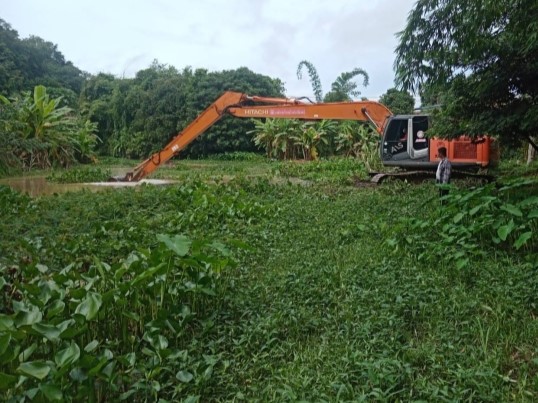Get to Know… "Buoy Loy"
When mentioning "Buoy Loy," many people might think of a beautiful type of lotus floating above the water. However, in this context, Buoy Loy is a local name used in northern Thailand to refer to water hyacinth (Eichhornia crassipes).
This plant is actually an alien species originating from South America. It was introduced to Thailand over 100 years ago from Java and has since rapidly grown and spread throughout rivers and canals. This unchecked expansion obstructs waterways and poses a significant threat to wetland ecosystems. As a result, it has been classified as an
Invasive Alien Species (IAS)—a species that negatively impacts native flora and fauna.
.jpg)
Water hyacinth is a floating aquatic plant that spreads via water currents and can survive in both hot and cold climates. It thrives in various water conditions, even in polluted environments where other aquatic plants might perish. This ability allows it to flourish in urban waterways receiving wastewater, significantly impacting water bodies and wetlands. Its dense growth disrupts water flow, accelerates sedimentation, and increases water evaporation rates. Moreover, dense clusters of water hyacinth reduce dissolved oxygen levels, negatively affecting fish populations, plankton, and other aquatic organisms. Additionally, it serves as a breeding ground for pests.
 Buoy Loy – A Serious Threat to Wetlands
Buoy Loy – A Serious Threat to Wetlands
In early 2025, the Thailand Environment Institute (TEI) conducted a survey of several key wetlands in Chiang Rai province. The findings revealed that water hyacinth had spread almost everywhere, particularly in community and urban wetlands. For example, Nong Saen To in Chiang Rai Municipality, a local wetland, is now completely covered by water hyacinth, forcing fishermen to use bamboo barriers to clear space for fishing.

Similarly, at Nong Bong Khai Non-Hunting Area in Chiang Saen district—the only Ramsar Site (internationally significant wetland) in northern Thailand—water hyacinth is considered a major ecological threat requiring urgent intervention. The head of the non-hunting area emphasized:
"The most critical threat to Nong Bong Khai Wetland is the dense presence of water hyacinth. During high water periods, the plants spread widely, blocking sunlight and disrupting the growth of algae and aquatic species. Eliminating them requires heavy machinery and significant funding."
A similar situation exists at Nong Luang, a large wetland spanning over 9,000 rai (approximately 1,440 hectares) in Wiang Chai district, recognized as a nationally significant wetland. Water hyacinth proliferates across vast areas, particularly during the dry season when water levels are low. This negatively impacts local fisheries and eco-tourism, as noted by a leader of the community tourism group:
"There’s an overwhelming amount of Buoy Loy here. During the dry season, the roots anchor into the soil, blocking boat routes, making it impossible to offer rafting tours. Despite multiple removal efforts by different agencies, the plants always return in full force."
How We Can Help?
According to research conducted by TEI, Thailand has made ongoing efforts to control water hyacinth. However, complete eradication remains
challenging and costly, requiring multiple approaches:
- Chemical Control – Using herbicides like chlorophenoxy and glyphosate. This method is simple but carries potential environmental risks.
- Mechanical Removal – Utilizing human labor, animals, tools, or machines to physically remove the plants by pulling, dragging, or scooping them out of the water. While environmentally friendly, this method is labor-intensive and expensive.
- Biological Control – Introducing insects, plant diseases, or natural predators that feed on or destroy water hyacinth. While effective, finding suitable biological agents for Thailand remains a challenge.

Despite its threats, water hyacinth can be repurposed for various uses, such as: Animal feed, fertilizer, and mushroom cultivation material, crafting woven products and biodegradable packaging, biogas production, etc.
However, experts emphasize that complete eradication is only feasible if action is taken in the early stages of an outbreak, when the infestation is small and localized.
We can all help mitigate the spread of water hyacinth by regularly dredging canals and waterways to maintain strong water flow, as the plant struggles to grow in fast-moving water. It is essential to monitor nearby water bodies and promptly remove any water hyacinth found, either by drying or burning it. Additionally, preventing chemical fertilizers from entering water sources through agricultural runoff and treating household wastewater before discharge are crucial steps to limiting nutrient enrichment and curbing the plant’s growth.
Protecting natural and man-made wetlands is crucial. Wetlands serve vital functions: absorbing floodwaters, storing water during droughts, providing habitats for aquatic species, preserving local culture, and supporting community tourism and economies.
Keywords: #BuoyLoy #WaterHyacinth #Wetlands
Sources: Thailand Environment Institute (TEI), Department of Water Resources, Regional Environment Office 5 (Nakhon Pathom), Medthai, and URBAN Project.
Source: TEI
.jpg)




Share: